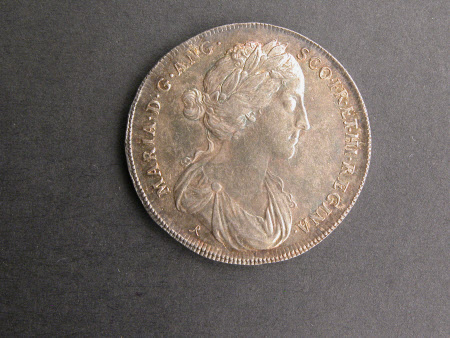The Coronation of Mary II
John Roettiers (1631- London 1703)
Category
Coins and medals
Date
1685
Materials
Silver
Measurements
331 mm (Diameter)
Place of origin
London
Order this imageCollection
Osterley Park and House, London
NT 773271
Summary
Silver, medal commemorating the coronation of Queen Mary II, by John Roettiers (1631-1703), struck London, United Kingdom, 1685. A silver medal by John Roettiers commemorating the coronation of Mary of Modena (Maria Beatrice Anna Margherita Isabella d’Este, 1658-1718) as Queen Mary II, which took place on 23 April 1685, alongside the coronation of her husband as King James II. The obverse has a bust portrait in profile of Mary facing right, with a laurel wreath in her hair, wearing a loose shift fastened with a button at the right shoulder. The artist’s monogram below the shoulder truncation. Latin legend ‘Mary by the Grace of God Queen of England, Scotland, France and Ireland.’ On the reverse, the Queen is seated upon a mound, facing right, with the legend ‘Assuredly a goddess’.
Full description
Mary (1658–1718) was queen of England, Scotland, and Ireland, and consort of James II and VII. Known popularly as Mary of Modena, she was born Maria Beatrice Anna Margherita Isabella d'Este, the first of two surviving children of Alfonso IV d'Este, duke of Modena and Reggio (1634–1662), and his wife, Laura (1639–1687). After the death of his first wife Anne Hyde in 1671, Charles II’s brother James, Duke of York, who had converted to Catholicism, sought a Roman Catholic to be his new wife. Since neither Charles nor James had produced a legitimate male heir, the question of a new consort became a matter of even greater public interest. There was widespread opposition to a Catholic bride, in Parliament and among the population more broadly, which feared both the immediate threat to the Protestant succession and the wider religious settlement within the nation. Eventually the choice fell upon the young Maria Beatrice, who had had no wish to marry, instead expressing her desire to become a nun. She was nevertheless forced to sacrifice her personal wishes, largely because of pressure exerted by the French, who saw the marriage as their best means of maintaining a close alliance with Britain, and by Pope Clement X. After a proxy wedding in Modena in September, the fifteen-year old Mary arrived in Dover on 21 November 1673, where she was greeted by her husband, with whom she travelled on to London. Mary settled in quickly to life at the English court and had a good relationship with Charles II and Queen Catherine. Although Mary was the focus of much anti-Catholic sentiment, especially in the fevered atmosphere of the Popish Plot of 1678-79, there is very little evidence for her having done anything to try to advance the cause of her religion in Britain. At the time of the accession of James II/VII to the English and Scottish thrones, in February 1685, the new king and his wife were childless, after they had endured a number of miscarriages and early deaths of children. The Coronation was unusual in that both the monarch and his consort were Catholics, taking part in a Protestant ceremony. Mary was also the first consort since 1603 to participate in a coronation. In the course of the day, she is said to have impressed those present with her beauty and the grace of her deportment. During the day she wore no fewer than three crowns, as well as a magnificent coronation dress and gowns, set with pearls and diamonds. This formal pomp is not at all apparent from John Roettiers’ medal, the official Coronation medal of the queen, made for distribution among spectators at the ceremony. In it, the queen is depicted in an all’antica form on the obverse, recalling a bust of a Roman empress, whilst the simply draped figure on the reverse is even more neo-classical in form. The image of Mary for the medal, as well as the legend on the reverse, both reflect contemporary reports which mostly comment favourably on her appearance. According to the Earl of Peterborough, who had undertaken the final negotiations for the marriage and represented the king at the proxy wedding ceremony in Modena in 1673, Mary was ‘tall and admirably shaped; her complexion was of the last degree of fairness, her hair black as jet; so were her eyebrows and her eyes, but the latter so full of light and sweetness, as they did dazzle and charm too.’ Jeremy Warren 2019
Provenance
Given to the National Trust in 1993 by George Child Villiers, 9th Earl of Jersey (1910-1998).
Marks and inscriptions
Obverse, legend: MARIA. D.G. ANG. SCO. FR. ET. HI. REGINA. Obverse, below truncation : JR Reverse, legend: O. DEA. CERTE.
Makers and roles
John Roettiers (1631- London 1703), medallist
References
Hawkins, Franks and Grueber 1885: Edward Hawkins, Augustus W. Franks and Herbert A. Grueber (eds.), Medallic Illustrations of the History of Great Britain and Ireland to the death of George II, 2 vols., London 1885, vol. I, p. 606, no. 7. Skeet 1930: Francis John Angus Skeet, Stuart Papers, Pictures, Relics, Medals and Books in the Collection of Miss Maria Widdrington, Leeds 1930, p. 70. Wollaston 1978: Henry Wollaston, The Commemorative Collectors Guide to British Official Medals for Coronations and Jubilees, Nottingham 1978, p. 7, no. 7. Eimer 2010: Christopher Eimer, British Commemorative Medals and their Values, London 2010, p. 61, no. 274, pl. 34.
